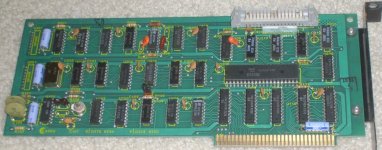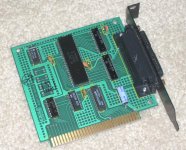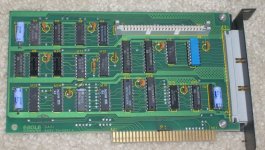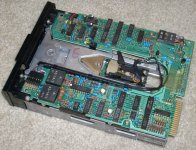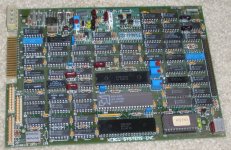SomeGuy
Veteran Member
The Eagle 1600 computer
The other day a beat-up rustbucket Eagle 1600 model 1630 came up on eBay, finally for a reasonable price. So I grabbed it, and decided to test its compatibility if I could get it running.
The Eagle 1600 is an interesting computer because it was the second IBM PC clone after the Columbia Data Product 1600 (Marketing must have really liked the number 1600).
However, magazine reviews of the time were heavily inconsistent describing its compatibility or lack thereof. Some referred to it as able to run any IBM PC software, while others referred to it as an MS-DOS hardware-incompatible. Yet others seem to confuse it with the slightly later "Eagle PC". And there is very little on the Internet about it today.
Surprisingly after a *LOT* of scrubbing and cleaning, it actually began to look halfway decent.
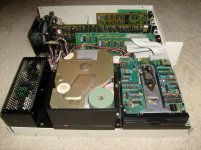
The video card was completely dead (It would not start up with the card in place), and there was no keyboard. But surprisingly I was able to drop in a generic clone monographics card, attach an XT compatible keyboard, and after hunting down several bad RAM chips, it WORKED!
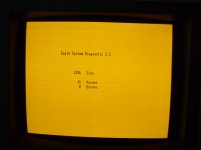
General System Specification:
Intel 8086-2 CPU. (8MHZ)
This unit has 512MB RAM, the first 128K bank is soldered on. Each bank has 16 DIP chips.
8 ISA compatible slots
96TPI 5.25" Quad-Density floppy drive.
Can read/write 360K disk.
10MB Internal MFM/SASI hard drive (dead)
No keyboard, but works with XT compatible keyboard (Arrow keys have issues)
Can boot IBM PC DOS and vanilla MS-DOS.
I never could find a exact release date for the 1600, but it would have been sometime in 1982. The Eagle 1600 was shortly followed up by the 8088-based, and reportedly more compatible, Eagle PC. Presumably the 1600 would have been targeted to higher-end workstation users, and the Eagle PC more towards common office and home users.
There is an Eagle Computer product list here: http://www.vintage-computer.com/vcforum/showthread.php?49510-Eagle-Computer-model-list
***Motherboard***

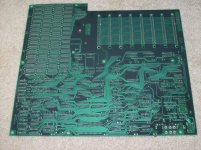
Larger Front: http://lucasm.cf/?zgm2n
Larger Back: http://lucasm.cf/?mddmz
There are no switches or jumpers on this board. All configuration is auto-detected.
It uses a 16-bit 8086. Norton (v4.5) SI reports a speed of 1.9. Speedcom thinks it runs like a 3.81mhz PC AT or a 10MHZ 8088.
Although it uses a 16-bit CPU, the motherboard has eight 8-bit ISA compatible slots. With the way most articles talked about this machine, I did not expect it would accept IBM expansion cards. But it does, with some limitations and possible bugs.
Motherboard resources such as PC-speaker and DMA controller seem software compatible with the IBM PC.
***BIOS***
Here is a dump of the ROMS if anyone wants it:
http://s000.tinyupload.com/index.php?file_id=88836190239801521353
The motherboard chip date codes suggest a manufacture date of early 1983. However, this BIOS has a date of 7/13/84, suggesting the BIOS was upgraded.
The BIOS identifies itself as EPROM VER 2.2
Since Eagle, according to Infoworld, was forced to stop shipping IBM code-infringing PCs on 3/7/1984, presumably this version would be free of any possible infringing code.
It appears this BIOS does not support ROM extensions. This means that normal hard disk controllers, VGA cards, and the XT-IDE BIOS driven cards do not function.
This also means some of the compatibility results here might differ from an original release.
It would be interesting to compare this version to an earlier version. The magazine articles speculated that this would reduce compatibility, but the additional work could have actually increased it.
Pressing "T" at boot launches a diagnostic program that tests the system and RAM.
Pressing "F" at boot forces a boot from the floppy. On a model 1630, it defaults to booting from the hard drive.
***RAM***
The ram chips on the motherboard are 200NS 64Kx1. They are added in banks of 16 chips. The motherboard accepts three additional banks for a maximum of 512K.
Theoretically, it might be possible to use an ISA memory expansion card, but the 8-bit data bus would make that slower.
The BIOS appears to support addition of RAM in 64K increments up to 640K.
***Keyboard***
The Eagle 1600 series shipped with a proprietary 24 function-key keyboard. However, these should operate on an IBM PC. They were also sold as an option with the Eagle PC.
Mine didn't come with a keyboard, so I can't be sure.
The keyboard attaches to a DIN plug on the side of the machine. From my testing, generic XT compatible keyboards work with the 1600, although some applications do not properly recognize keypresses from the arrow keys.
***Power Supply***
It has a very small proprietary form power supply (50/42 watts) that seems inadequate for running a hard drive. But somehow it manages.
-----Expansion Cards------
*** Paralel Port***
Photo: http://lucasm.cf/?yzc0n
This looks like it might be a parallel port card with a centronix plug?
I'm not really sure. Haven't had a chance to poke around with this one yet.
***Serial Card***
Picture: http://lucasm.cf/?mgrjo
This looks like a serial card. It looks to be non-IBM compatible.
The little bit I have found about this suggests this is a dual serial card with a single UART.
***Video Card***
Picture: http://lucasm.cf/?zwizz
This card appears to be dead. When it is plugged in, the system will not start (powers up but BIOS will not POST). That is too bad, because I would love to kick it around.
According to the one line of text I could find on the Internet about this, the Eagle 1600 uses a "720x352 graphics mode". (https://books.google.com/books?id=2...gle 1600 720x352&pg=PA54#v=onepage&q&f=false )
The card has 32K of RAM, and the DB-9 port seems to be wired for an IBM mono monitor. But it also has an RCA jack, perhaps for composite?
So perhaps this is something like a Hercules card? Although the Hercules was not released until a couple of years later. Even then, it was supposedly just a clone of the IBM MDA card with more RAM.
Eagle did also manufacture and sell their own optional CGA card for the 1600 and Eagle PC.
I tested both a generic Monographics card an a CGA card in the 1600. They both "worked" but with some glitches.
Most programs and diagnostics ran and looked OK, but some graphics appeared with vertical bars and text modes did not always draw color or highlights. If I get a chance perhaps I will dig in to that a bit more. It sort of smells like block copy/clear operations miss every other byte. This could be a compatibility issue with the 16-bit to 8-bit bus, but I wouldn't rule out possible motherboard damage.
***SASI Interface card***
Picture: http://lucasm.cf/?mjkwn
This card connects to a XEBEC SASI controller. There is no BIOS, so the code to use this must be in the motherboard ROM. Presumably this means it would not work on an IBM PC or other clone, even though this is an ISA card.
The BIOS appears to provide software compatible INT 13 disk services.
***Floppy disk controller***
Picture: http://lucasm.cf/?owjlo
Again, although this is an ISA style card, it is not IBM PC compatible. It will not work in place of an IBM PC floppy controller or vice versa.
The ImageDisk TestFDC tool fails. This tool talks directly to the hardware and requires full compatibility. There is no disk activity and it returns a "no FDC interrupt" error.
However the system is software compatible at the BIOS level. Tools such as the NFORMAT disk formatter work.
The BIOS hides the drive's double-stepping from IBM software. There is no way for vanilla DOS to use the native 96TPI/~720K capability.
***Floppy Drive***
Picture: http://lucasm.cf/?mjyzo
The floppy drive is a Mitsubishi M4853 96TPI 5.25" 300RPM drive. (Apparently these were also used in the Tandy 2000)
The disk controller uses a flat non-twisted cable, and the drive is set to DS0.
The Eagle 1600 model 1620 would have dual floppy drives. The 1630 has only a single floppy.
This drive runs the motor constantly, even when the drive is open. Given the small power supply, you would think it would not. Instead it has a lever that raises the head when it is not reading/writing. Off hand I don't know if it would encounter any compatibility issues if this behavior were changed.
This system is designed to use an 800K 5.25" Quad-Density floppy disk format
The geometry is: 5 sectors of 1024 bytes, 80 tracks, double sided, MFM encoding, 250Khz at 300RPM.
Its DOS/BIOS somehow knows to double step when using PC-DOS or MS-DOS 360K disks.
360K disks formatted or written to in this drive may suffer from similar interoperability problems as 360K disks formatted in IBM AT 1.2MB drives when read in 360K drives.
On the up side, 360K disks formatted in 1.2mb drives will always work fine in this drive.
***Hard Drive***
Picture: http://lucasm.cf/?zjvmn
The Eagle 1600 model 1630 includes a pre-installed internal hard disk drive. Reportedly this was the first IBM-compatible to do this (Columbia Data Products must have shipped hard disk models later, and this pre-dated the IBM XT)
This hard disk is a Computer Memories Inc, Model CM 5412 10mb MFM drive.
***SASI Controller/Bridge***
Picture:http://lucasm.cf/?y2uxy
The drive is connected to a XEBEC SASI Controller that is mounted underneath the floppy drive. The controller is marked Assy 104525 Rev-06 / 73-106. This controller is then connected to the Interface card above.
Eagle was already using this SASI controller in their Z80 based CP/M machines.
This seems to be similar to the XEBEC 104524C/S1410, for which there are manuals floating around.
After some chugging, my hard drive eventually spun up. It didn't seem to do anything, but after some futzing I discoverer that the head stepper motor had seized up. Removing the hard drives circuit board I was able to access the external portion of the hard drive arm. With some effort, it came free.
And then... it booted! Well, once. And then lots and lots and lots of read errors.
***DOS***
This Eagle 1600 had an Eagle OEM version of MS-DOS 2.1 on it. I was able to create a boot disk just before the hard drive crapped out.
Here it is if it is of any use to anyone (Eagle 800k format):
http://s000.tinyupload.com/index.php?file_id=27513866632550841821
There is a more complete Eagle OEM version of MS-DOS 2.0 on bitsavers:
http://bitsavers.trailing-edge.com/bits/EagleComputer/5inch/
However this appears to be packaged for the Eagle PC or Eagle Spirit. Most notably, the HDINIT tool does not recognize the Eagle 1600 SASI card (And I didn't find a hard disk tool on the hard drive). It does support the Eagle 800K 96TPI format, however.
On a 360K disk, the Eagle OEM DOS will boot on an IBM PC. And IBM PC-DOS or Vanilla MS-DOS will boot on an Eagle 1600. I was also able to boot several IBM "booter" programs, but ran in to graphical glitches.
PC/MS-DOS can not use the 800K format, nor will the 800K format read or boot on a PC. Interestingly, however, I was able to format and read an Eagle 800K disk from a regular PC using the Eagle OEM DOS.
Sadly, the Eagle Computer OEM MS-DOS 1.x is still not out there anywhere. It also would have used the Quad Density format, and was peculiar because it reportedly could recognize these hard drives, but as drive "A:" and without subdirectories.
Eagle MS-DOS 2.0 and 2.1 recognize the hard disk as C: like any other DOS.
-----
So in conclusion, the Eagle 1600 is somewhat IBM-PC hardware compatible, and designed as such. But, it is an odd duck with enough incompatible hardware that would have made interoperation with other PC software or hardware very problematic.
PS, would anyone happen to have the correct SASI low-level formatter tool for this system?
The other day a beat-up rustbucket Eagle 1600 model 1630 came up on eBay, finally for a reasonable price. So I grabbed it, and decided to test its compatibility if I could get it running.
The Eagle 1600 is an interesting computer because it was the second IBM PC clone after the Columbia Data Product 1600 (Marketing must have really liked the number 1600).
However, magazine reviews of the time were heavily inconsistent describing its compatibility or lack thereof. Some referred to it as able to run any IBM PC software, while others referred to it as an MS-DOS hardware-incompatible. Yet others seem to confuse it with the slightly later "Eagle PC". And there is very little on the Internet about it today.
Surprisingly after a *LOT* of scrubbing and cleaning, it actually began to look halfway decent.

The video card was completely dead (It would not start up with the card in place), and there was no keyboard. But surprisingly I was able to drop in a generic clone monographics card, attach an XT compatible keyboard, and after hunting down several bad RAM chips, it WORKED!

General System Specification:
Intel 8086-2 CPU. (8MHZ)
This unit has 512MB RAM, the first 128K bank is soldered on. Each bank has 16 DIP chips.
8 ISA compatible slots
96TPI 5.25" Quad-Density floppy drive.
Can read/write 360K disk.
10MB Internal MFM/SASI hard drive (dead)
No keyboard, but works with XT compatible keyboard (Arrow keys have issues)
Can boot IBM PC DOS and vanilla MS-DOS.
I never could find a exact release date for the 1600, but it would have been sometime in 1982. The Eagle 1600 was shortly followed up by the 8088-based, and reportedly more compatible, Eagle PC. Presumably the 1600 would have been targeted to higher-end workstation users, and the Eagle PC more towards common office and home users.
There is an Eagle Computer product list here: http://www.vintage-computer.com/vcforum/showthread.php?49510-Eagle-Computer-model-list
***Motherboard***


Larger Front: http://lucasm.cf/?zgm2n
Larger Back: http://lucasm.cf/?mddmz
There are no switches or jumpers on this board. All configuration is auto-detected.
It uses a 16-bit 8086. Norton (v4.5) SI reports a speed of 1.9. Speedcom thinks it runs like a 3.81mhz PC AT or a 10MHZ 8088.
Although it uses a 16-bit CPU, the motherboard has eight 8-bit ISA compatible slots. With the way most articles talked about this machine, I did not expect it would accept IBM expansion cards. But it does, with some limitations and possible bugs.
Motherboard resources such as PC-speaker and DMA controller seem software compatible with the IBM PC.
***BIOS***
Here is a dump of the ROMS if anyone wants it:
http://s000.tinyupload.com/index.php?file_id=88836190239801521353
The motherboard chip date codes suggest a manufacture date of early 1983. However, this BIOS has a date of 7/13/84, suggesting the BIOS was upgraded.
The BIOS identifies itself as EPROM VER 2.2
Since Eagle, according to Infoworld, was forced to stop shipping IBM code-infringing PCs on 3/7/1984, presumably this version would be free of any possible infringing code.
It appears this BIOS does not support ROM extensions. This means that normal hard disk controllers, VGA cards, and the XT-IDE BIOS driven cards do not function.
This also means some of the compatibility results here might differ from an original release.
It would be interesting to compare this version to an earlier version. The magazine articles speculated that this would reduce compatibility, but the additional work could have actually increased it.
Pressing "T" at boot launches a diagnostic program that tests the system and RAM.
Pressing "F" at boot forces a boot from the floppy. On a model 1630, it defaults to booting from the hard drive.
***RAM***
The ram chips on the motherboard are 200NS 64Kx1. They are added in banks of 16 chips. The motherboard accepts three additional banks for a maximum of 512K.
Theoretically, it might be possible to use an ISA memory expansion card, but the 8-bit data bus would make that slower.
The BIOS appears to support addition of RAM in 64K increments up to 640K.
***Keyboard***
The Eagle 1600 series shipped with a proprietary 24 function-key keyboard. However, these should operate on an IBM PC. They were also sold as an option with the Eagle PC.
Mine didn't come with a keyboard, so I can't be sure.
The keyboard attaches to a DIN plug on the side of the machine. From my testing, generic XT compatible keyboards work with the 1600, although some applications do not properly recognize keypresses from the arrow keys.
***Power Supply***
It has a very small proprietary form power supply (50/42 watts) that seems inadequate for running a hard drive. But somehow it manages.
-----Expansion Cards------
*** Paralel Port***
Photo: http://lucasm.cf/?yzc0n
This looks like it might be a parallel port card with a centronix plug?
I'm not really sure. Haven't had a chance to poke around with this one yet.
***Serial Card***
Picture: http://lucasm.cf/?mgrjo
This looks like a serial card. It looks to be non-IBM compatible.
The little bit I have found about this suggests this is a dual serial card with a single UART.
***Video Card***
Picture: http://lucasm.cf/?zwizz
This card appears to be dead. When it is plugged in, the system will not start (powers up but BIOS will not POST). That is too bad, because I would love to kick it around.
According to the one line of text I could find on the Internet about this, the Eagle 1600 uses a "720x352 graphics mode". (https://books.google.com/books?id=2...gle 1600 720x352&pg=PA54#v=onepage&q&f=false )
The card has 32K of RAM, and the DB-9 port seems to be wired for an IBM mono monitor. But it also has an RCA jack, perhaps for composite?
So perhaps this is something like a Hercules card? Although the Hercules was not released until a couple of years later. Even then, it was supposedly just a clone of the IBM MDA card with more RAM.
Eagle did also manufacture and sell their own optional CGA card for the 1600 and Eagle PC.
I tested both a generic Monographics card an a CGA card in the 1600. They both "worked" but with some glitches.
Most programs and diagnostics ran and looked OK, but some graphics appeared with vertical bars and text modes did not always draw color or highlights. If I get a chance perhaps I will dig in to that a bit more. It sort of smells like block copy/clear operations miss every other byte. This could be a compatibility issue with the 16-bit to 8-bit bus, but I wouldn't rule out possible motherboard damage.
***SASI Interface card***
Picture: http://lucasm.cf/?mjkwn
This card connects to a XEBEC SASI controller. There is no BIOS, so the code to use this must be in the motherboard ROM. Presumably this means it would not work on an IBM PC or other clone, even though this is an ISA card.
The BIOS appears to provide software compatible INT 13 disk services.
***Floppy disk controller***
Picture: http://lucasm.cf/?owjlo
Again, although this is an ISA style card, it is not IBM PC compatible. It will not work in place of an IBM PC floppy controller or vice versa.
The ImageDisk TestFDC tool fails. This tool talks directly to the hardware and requires full compatibility. There is no disk activity and it returns a "no FDC interrupt" error.
However the system is software compatible at the BIOS level. Tools such as the NFORMAT disk formatter work.
The BIOS hides the drive's double-stepping from IBM software. There is no way for vanilla DOS to use the native 96TPI/~720K capability.
***Floppy Drive***
Picture: http://lucasm.cf/?mjyzo
The floppy drive is a Mitsubishi M4853 96TPI 5.25" 300RPM drive. (Apparently these were also used in the Tandy 2000)
The disk controller uses a flat non-twisted cable, and the drive is set to DS0.
The Eagle 1600 model 1620 would have dual floppy drives. The 1630 has only a single floppy.
This drive runs the motor constantly, even when the drive is open. Given the small power supply, you would think it would not. Instead it has a lever that raises the head when it is not reading/writing. Off hand I don't know if it would encounter any compatibility issues if this behavior were changed.
This system is designed to use an 800K 5.25" Quad-Density floppy disk format
The geometry is: 5 sectors of 1024 bytes, 80 tracks, double sided, MFM encoding, 250Khz at 300RPM.
Its DOS/BIOS somehow knows to double step when using PC-DOS or MS-DOS 360K disks.
360K disks formatted or written to in this drive may suffer from similar interoperability problems as 360K disks formatted in IBM AT 1.2MB drives when read in 360K drives.
On the up side, 360K disks formatted in 1.2mb drives will always work fine in this drive.
***Hard Drive***
Picture: http://lucasm.cf/?zjvmn
The Eagle 1600 model 1630 includes a pre-installed internal hard disk drive. Reportedly this was the first IBM-compatible to do this (Columbia Data Products must have shipped hard disk models later, and this pre-dated the IBM XT)
This hard disk is a Computer Memories Inc, Model CM 5412 10mb MFM drive.
***SASI Controller/Bridge***
Picture:http://lucasm.cf/?y2uxy
The drive is connected to a XEBEC SASI Controller that is mounted underneath the floppy drive. The controller is marked Assy 104525 Rev-06 / 73-106. This controller is then connected to the Interface card above.
Eagle was already using this SASI controller in their Z80 based CP/M machines.
This seems to be similar to the XEBEC 104524C/S1410, for which there are manuals floating around.
After some chugging, my hard drive eventually spun up. It didn't seem to do anything, but after some futzing I discoverer that the head stepper motor had seized up. Removing the hard drives circuit board I was able to access the external portion of the hard drive arm. With some effort, it came free.
And then... it booted! Well, once. And then lots and lots and lots of read errors.
***DOS***
This Eagle 1600 had an Eagle OEM version of MS-DOS 2.1 on it. I was able to create a boot disk just before the hard drive crapped out.
Here it is if it is of any use to anyone (Eagle 800k format):
http://s000.tinyupload.com/index.php?file_id=27513866632550841821
There is a more complete Eagle OEM version of MS-DOS 2.0 on bitsavers:
http://bitsavers.trailing-edge.com/bits/EagleComputer/5inch/
However this appears to be packaged for the Eagle PC or Eagle Spirit. Most notably, the HDINIT tool does not recognize the Eagle 1600 SASI card (And I didn't find a hard disk tool on the hard drive). It does support the Eagle 800K 96TPI format, however.
On a 360K disk, the Eagle OEM DOS will boot on an IBM PC. And IBM PC-DOS or Vanilla MS-DOS will boot on an Eagle 1600. I was also able to boot several IBM "booter" programs, but ran in to graphical glitches.
PC/MS-DOS can not use the 800K format, nor will the 800K format read or boot on a PC. Interestingly, however, I was able to format and read an Eagle 800K disk from a regular PC using the Eagle OEM DOS.
Sadly, the Eagle Computer OEM MS-DOS 1.x is still not out there anywhere. It also would have used the Quad Density format, and was peculiar because it reportedly could recognize these hard drives, but as drive "A:" and without subdirectories.
Eagle MS-DOS 2.0 and 2.1 recognize the hard disk as C: like any other DOS.
-----
So in conclusion, the Eagle 1600 is somewhat IBM-PC hardware compatible, and designed as such. But, it is an odd duck with enough incompatible hardware that would have made interoperation with other PC software or hardware very problematic.
PS, would anyone happen to have the correct SASI low-level formatter tool for this system?
Last edited:


